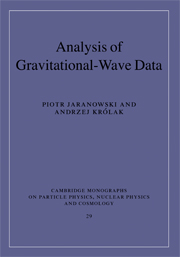Book contents
- Frontmatter
- Contents
- Preface
- Notation and conventions
- 1 Overview of the theory of gravitational radiation
- 2 Astrophysical sources of gravitational waves
- 3 Statistical theory of signal detection
- 4 Time series analysis
- 5 Responses of detectors to gravitational waves
- 6 Maximum-likelihood detection in Gaussian noise
- 7 Data analysis tools
- Appendix A The chirp waveform
- Appendix B Proof of the Neyman–Pearson lemma
- Appendix C Detector's beam-pattern functions
- Appendix D Response of the LISA detector to an almost monochromatic wave
- Appendix E Amplitude parameters of periodic waves
- References
- Index
Preface
Published online by Cambridge University Press: 08 January 2010
- Frontmatter
- Contents
- Preface
- Notation and conventions
- 1 Overview of the theory of gravitational radiation
- 2 Astrophysical sources of gravitational waves
- 3 Statistical theory of signal detection
- 4 Time series analysis
- 5 Responses of detectors to gravitational waves
- 6 Maximum-likelihood detection in Gaussian noise
- 7 Data analysis tools
- Appendix A The chirp waveform
- Appendix B Proof of the Neyman–Pearson lemma
- Appendix C Detector's beam-pattern functions
- Appendix D Response of the LISA detector to an almost monochromatic wave
- Appendix E Amplitude parameters of periodic waves
- References
- Index
Summary
Gravitational waves are predicted by Einstein's general theory of relativity. The only potentially detectable sources of gravitational waves are of astrophysical origin. So far the existence of gravitational waves has only been confirmed indirectly from radio observations of binary pulsars, notably the famous Hulse and Taylor pulsar PSR B1913+16 [1]. As gravitational waves are extremely weak, a very careful data analysis is required in order to detect them and extract useful astrophysical information. Any gravitational-wave signal present in the data will be buried in the noise of a detector. Thus the data from a gravitational-wave detector are realizations of a stochastic process. Consequently the problem of detecting gravitational-wave signals is a statistical one.
The purpose of this book is to introduce the reader to the field of gravitational-wave data analysis. This field has grown considerably in the past years as a result of commissioning a world-wide network of long arm interferometric detectors. This network together with an existing network of resonant detectors collects a very large amount of data that is currently being analyzed and interpreted. Plans exist to build more sensitive laser interferometric detectors and plans to build interferometric gravitational-wave detectors in space.
This book is meant both for researchers entering the field of gravitational-wave data analysis and the researchers currently analyzing the data. In our book we describe the basis of the theory of time series analysis, signal detection, and parameter estimation. We show how this theory applies to various cases of gravitational-wave signals. In our applications we usually assume that the noise in the detector is a Gaussian and stationary stochastic process.
- Type
- Chapter
- Information
- Analysis of Gravitational-Wave Data , pp. vii - ixPublisher: Cambridge University PressPrint publication year: 2009



